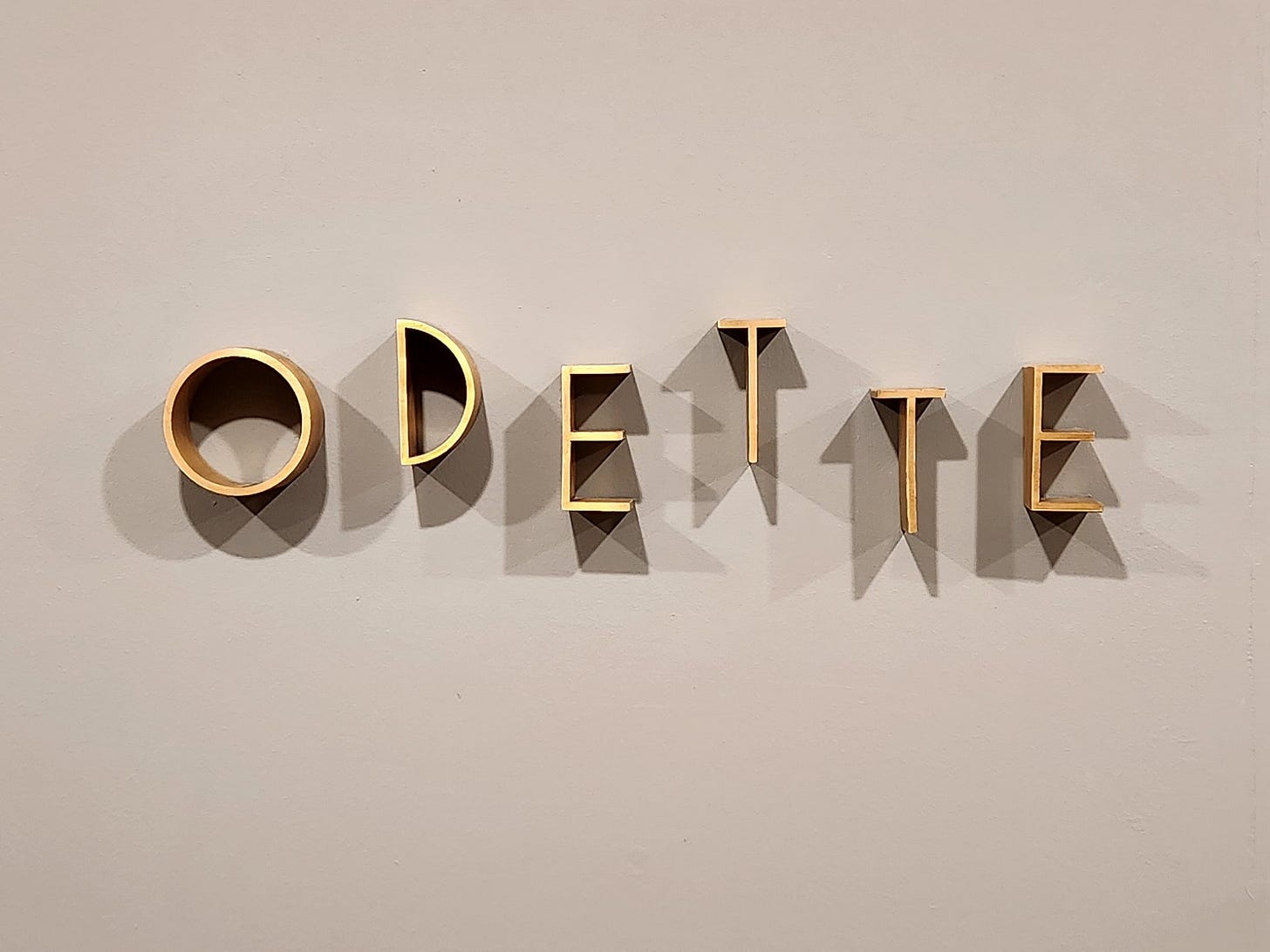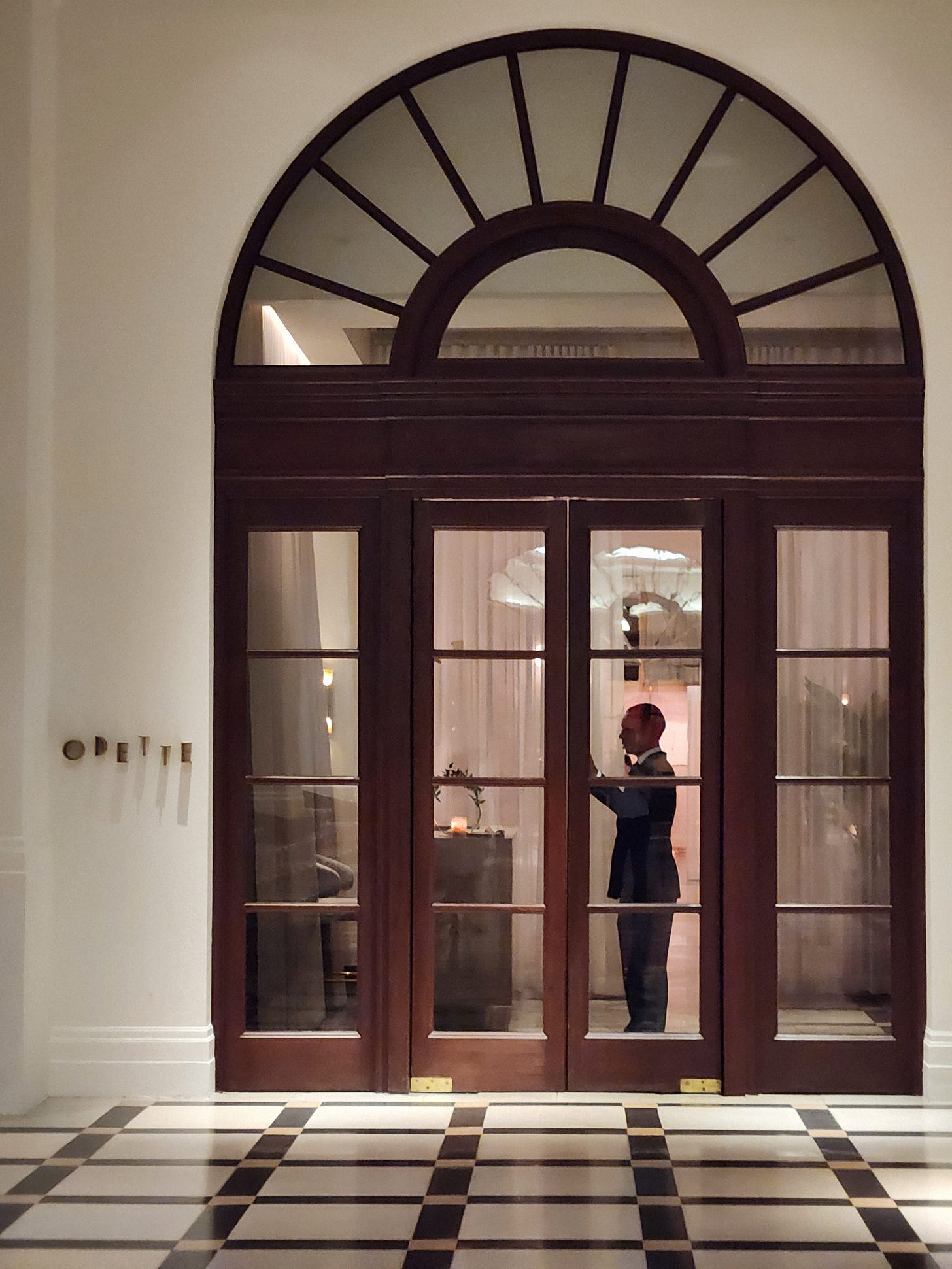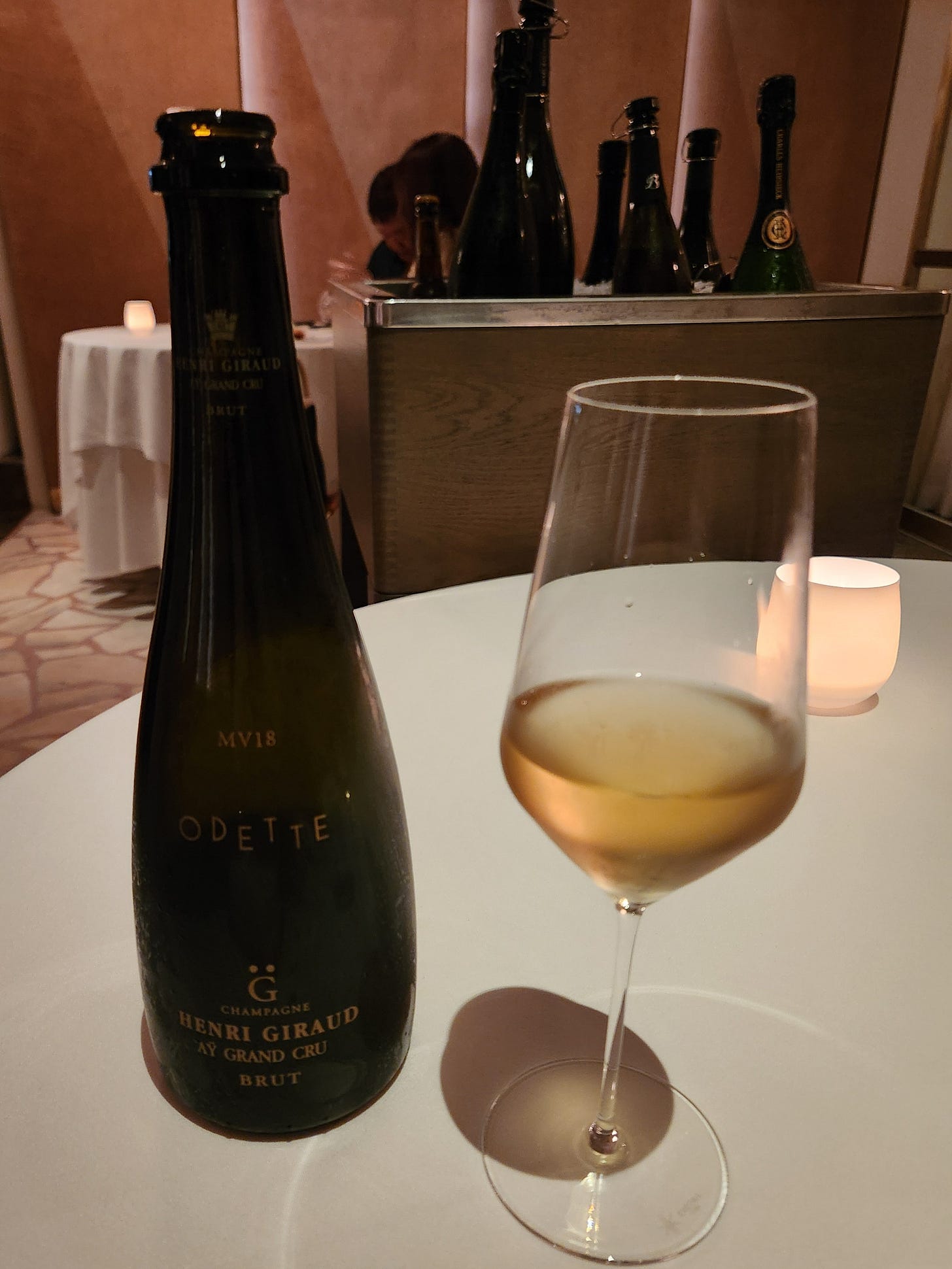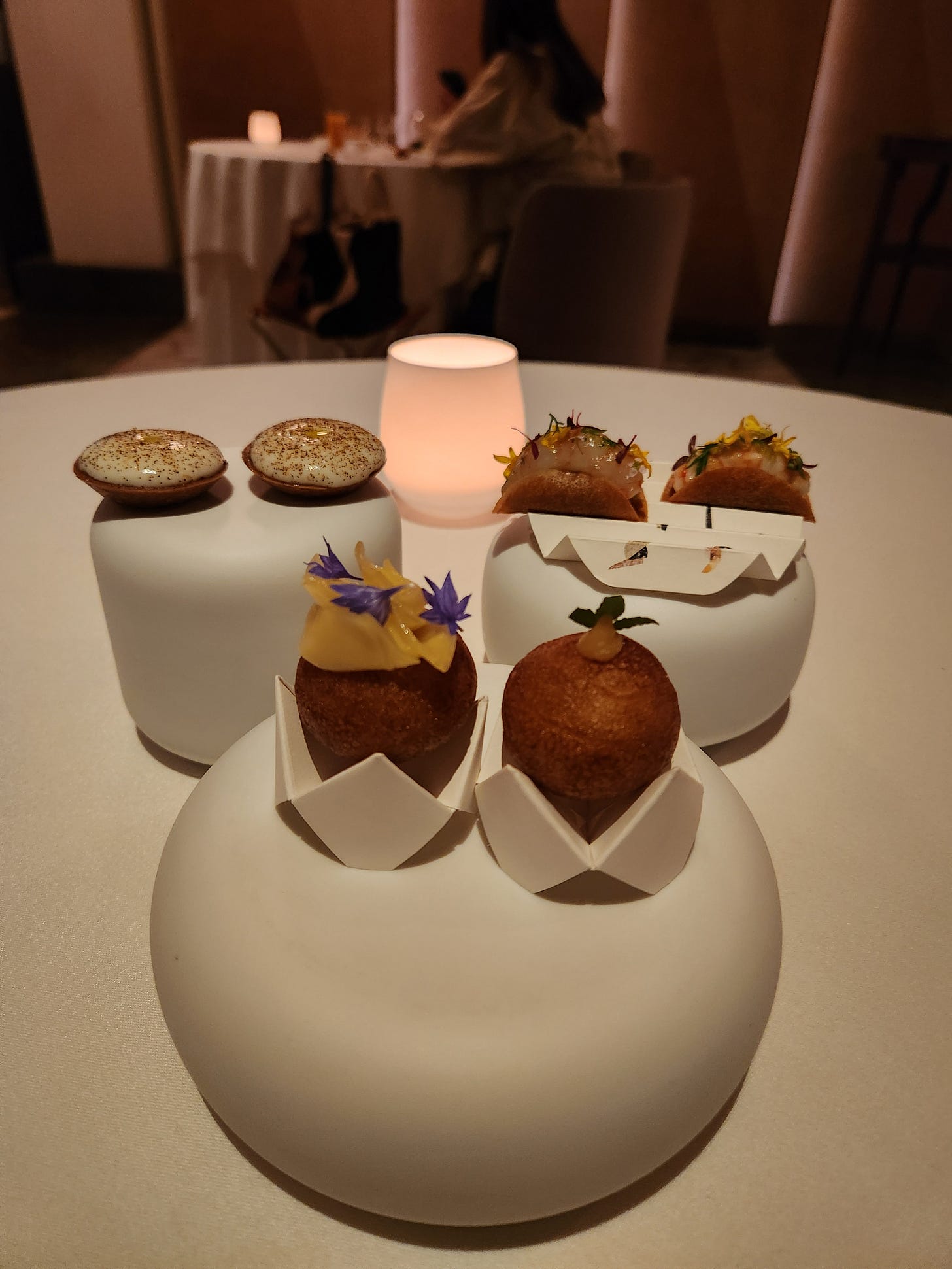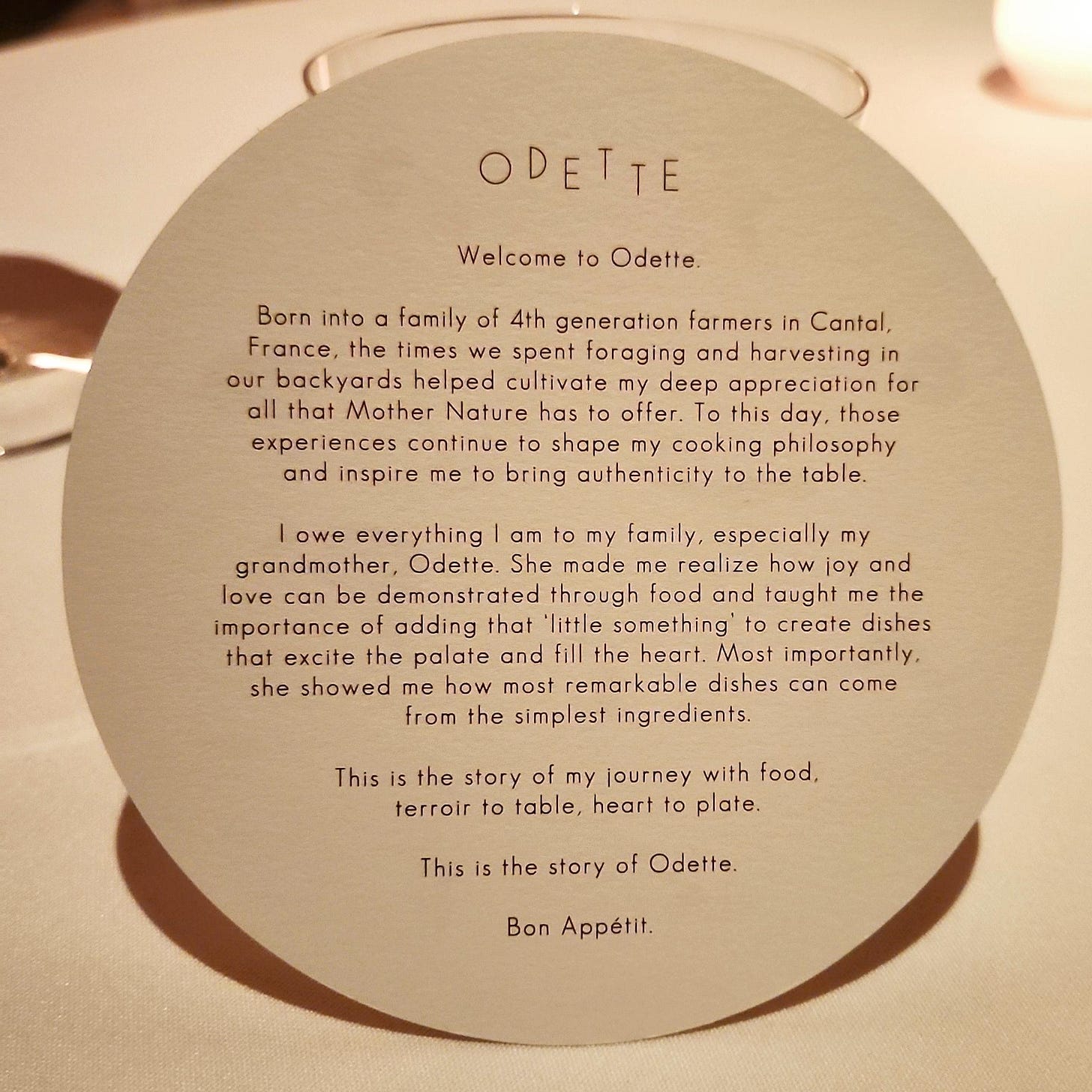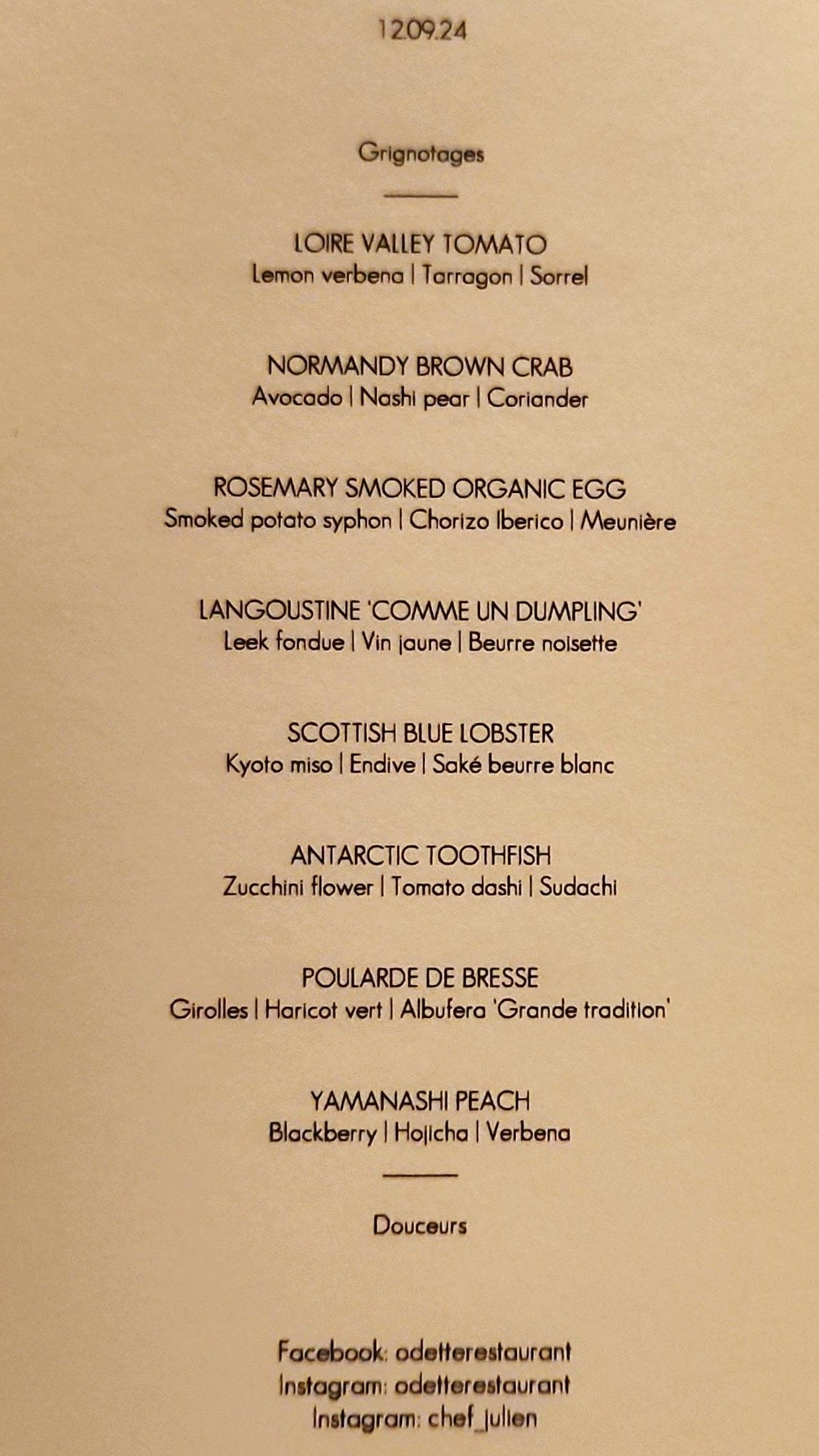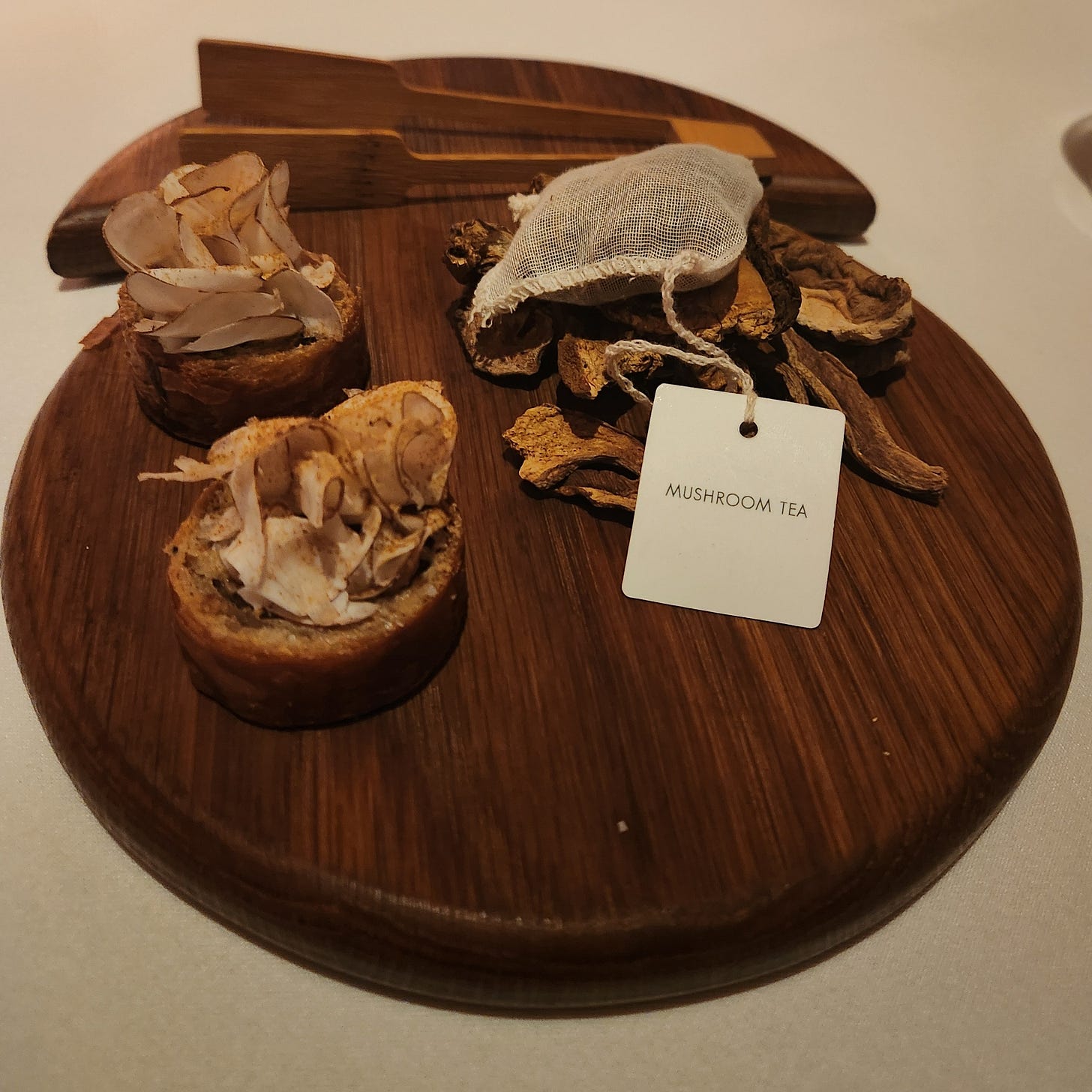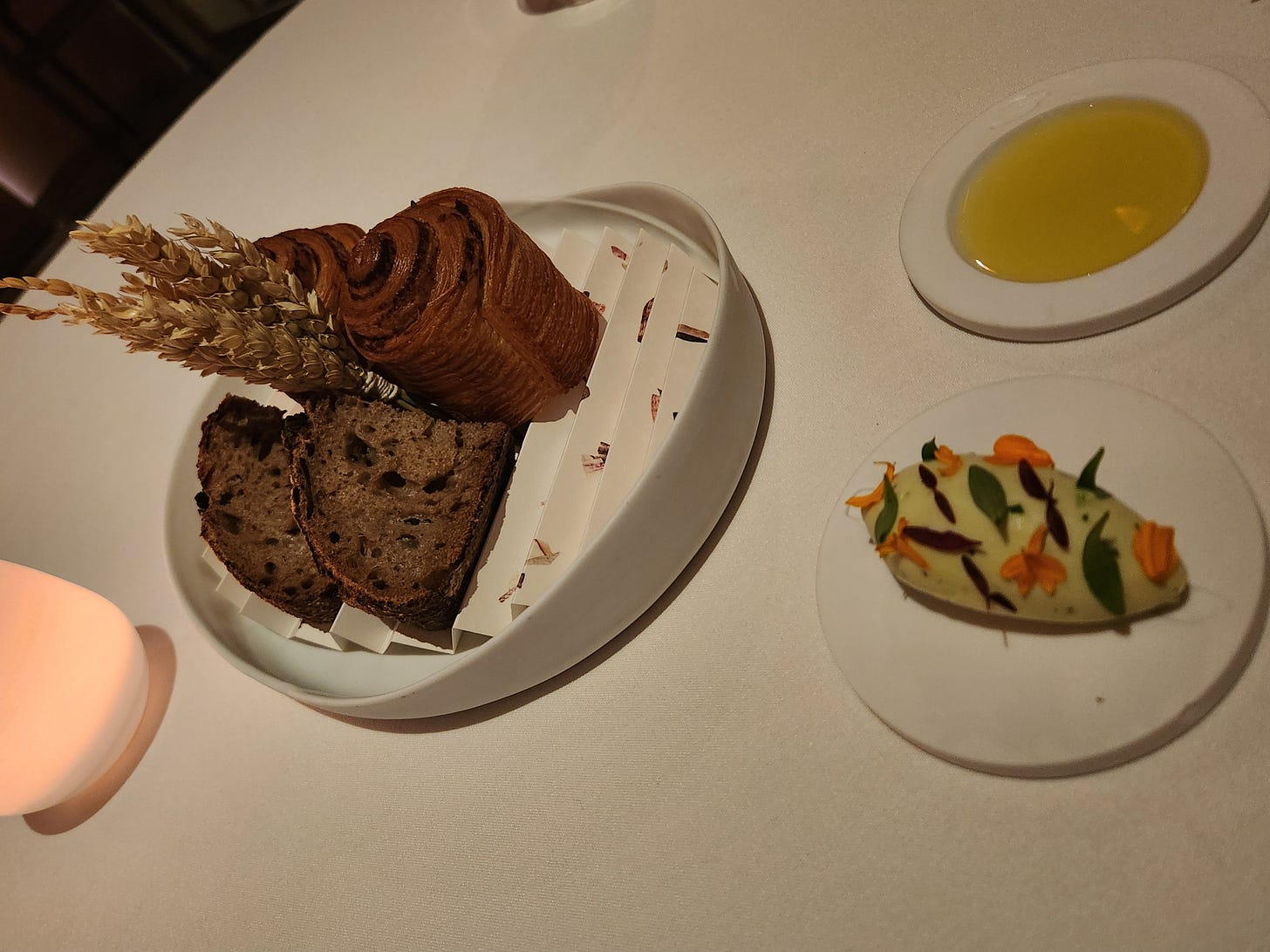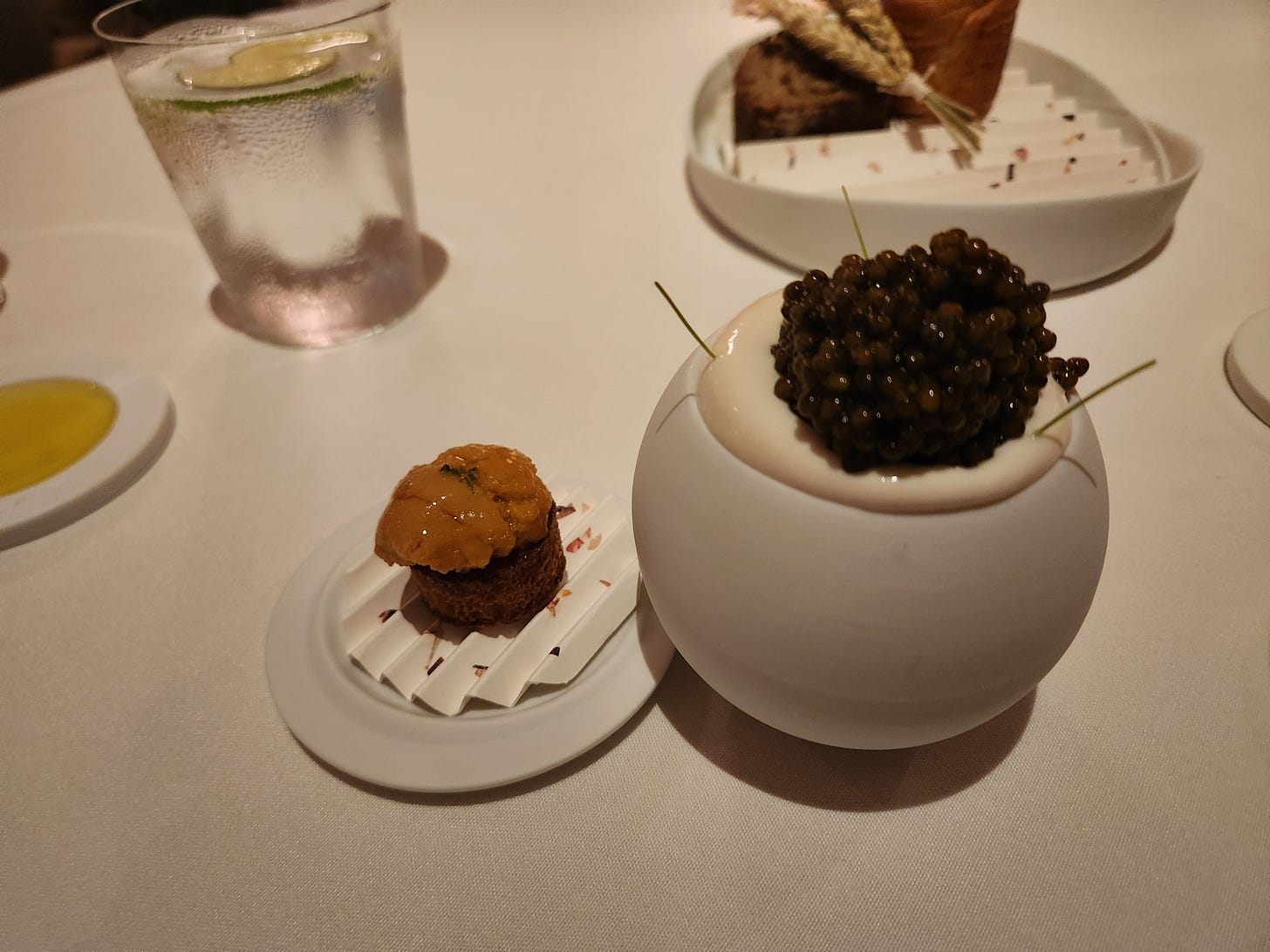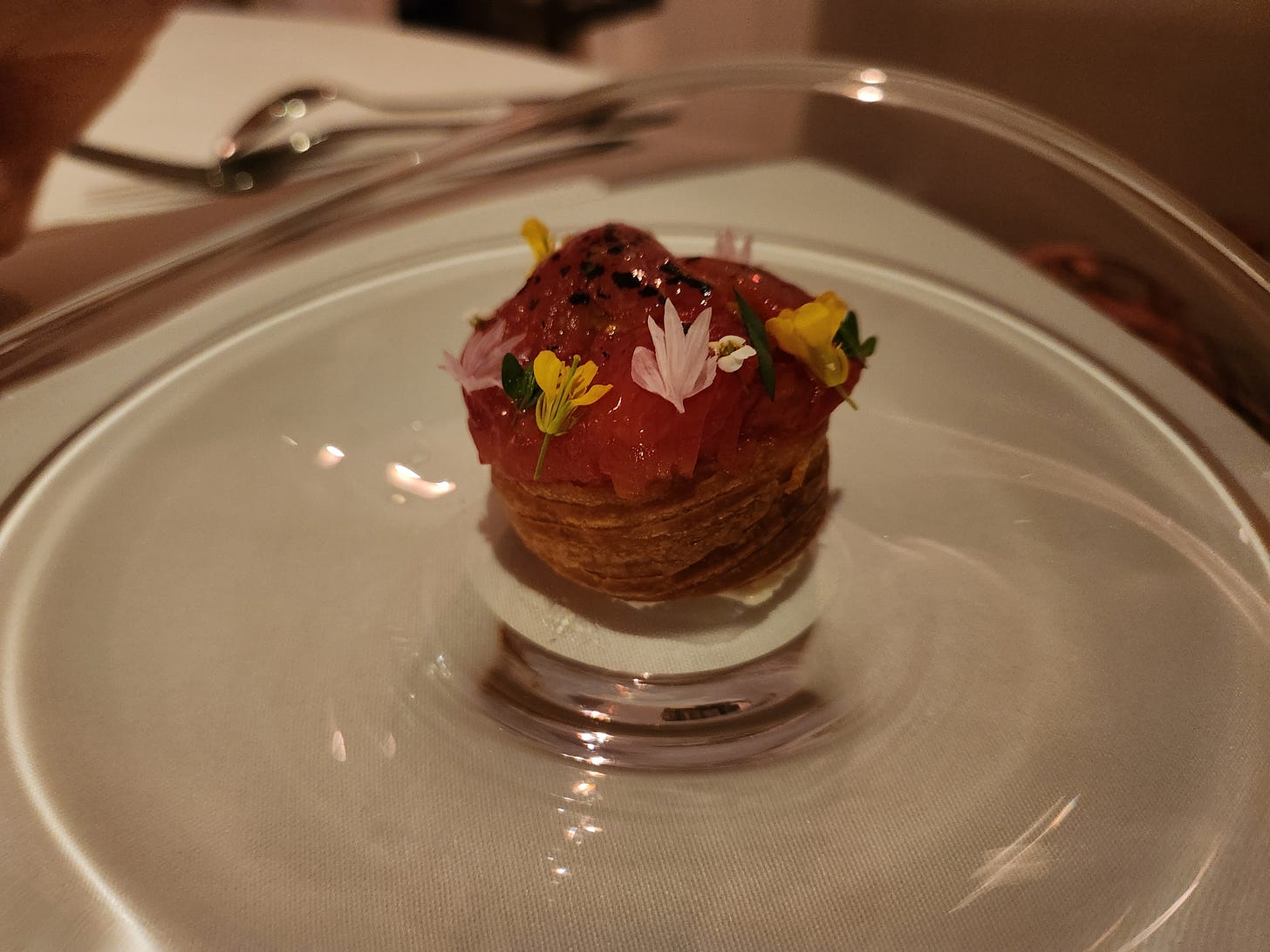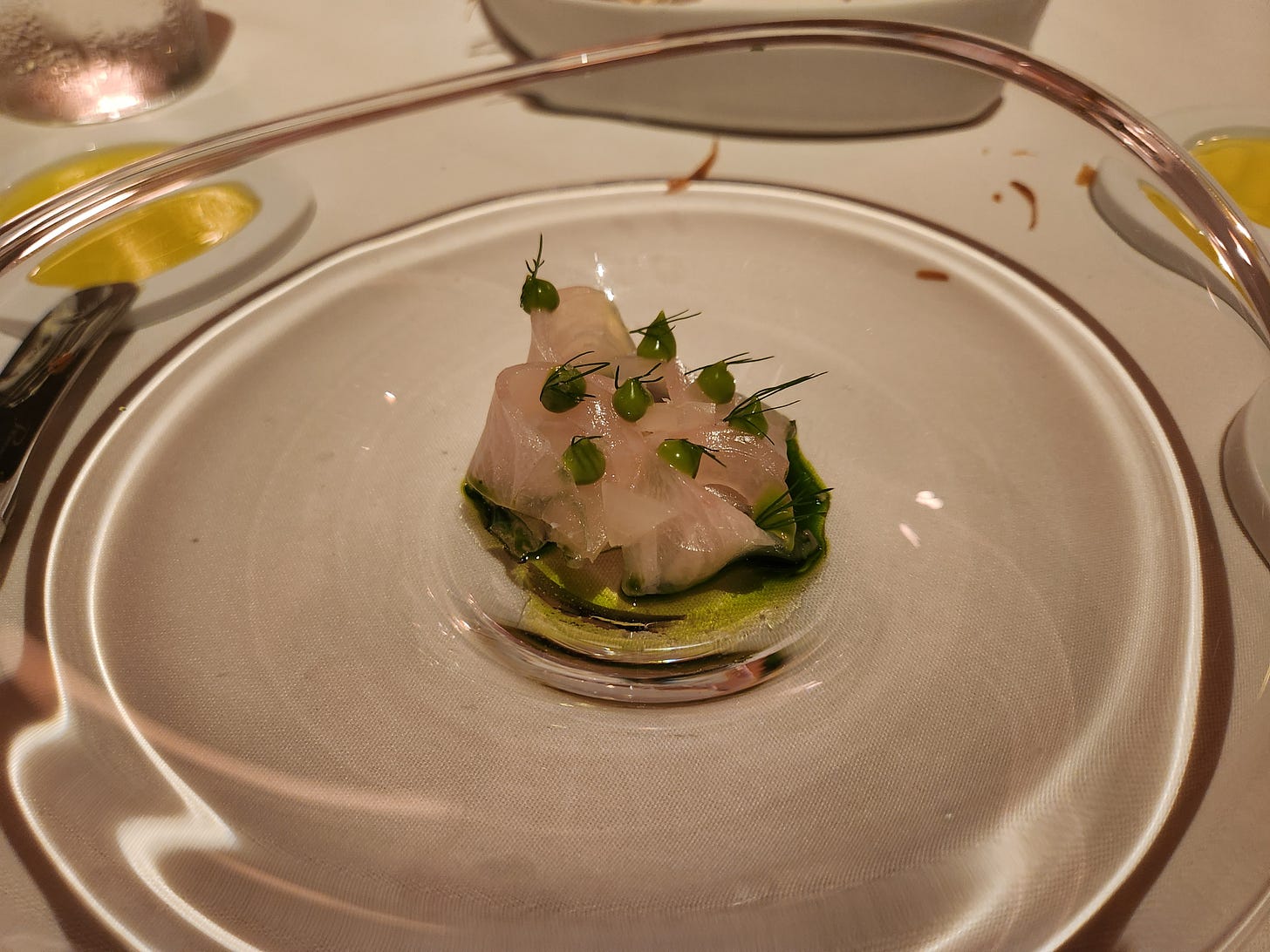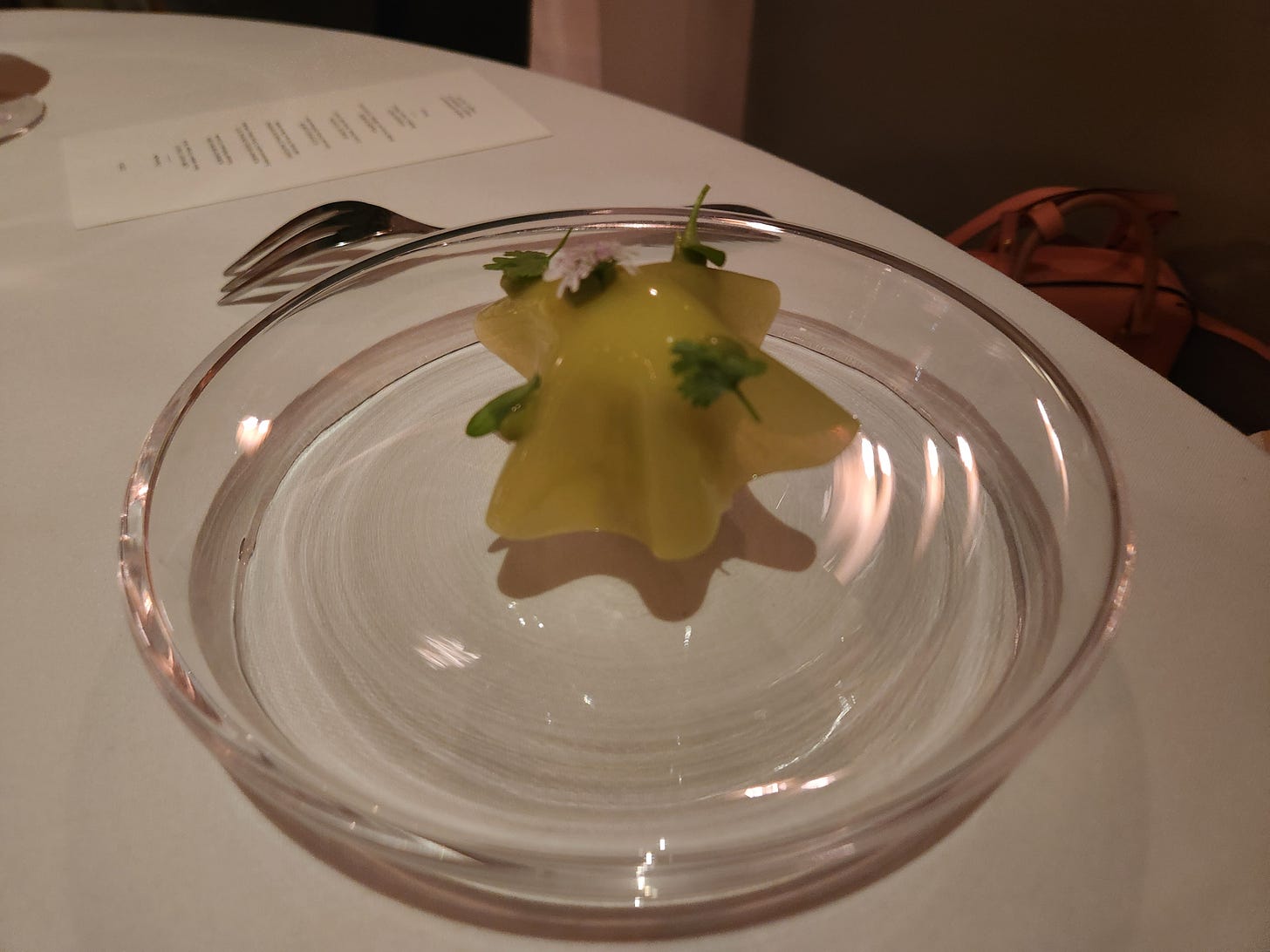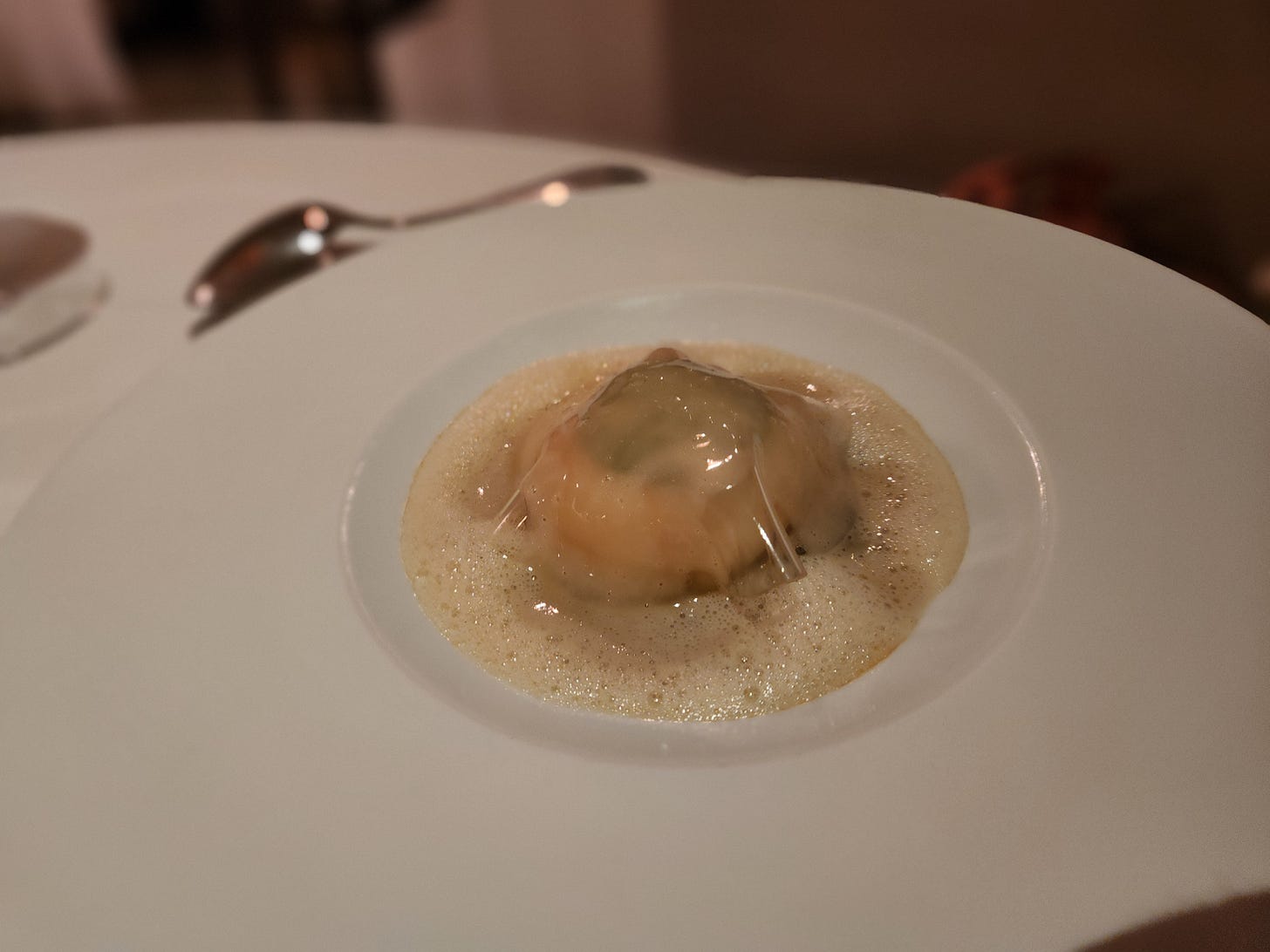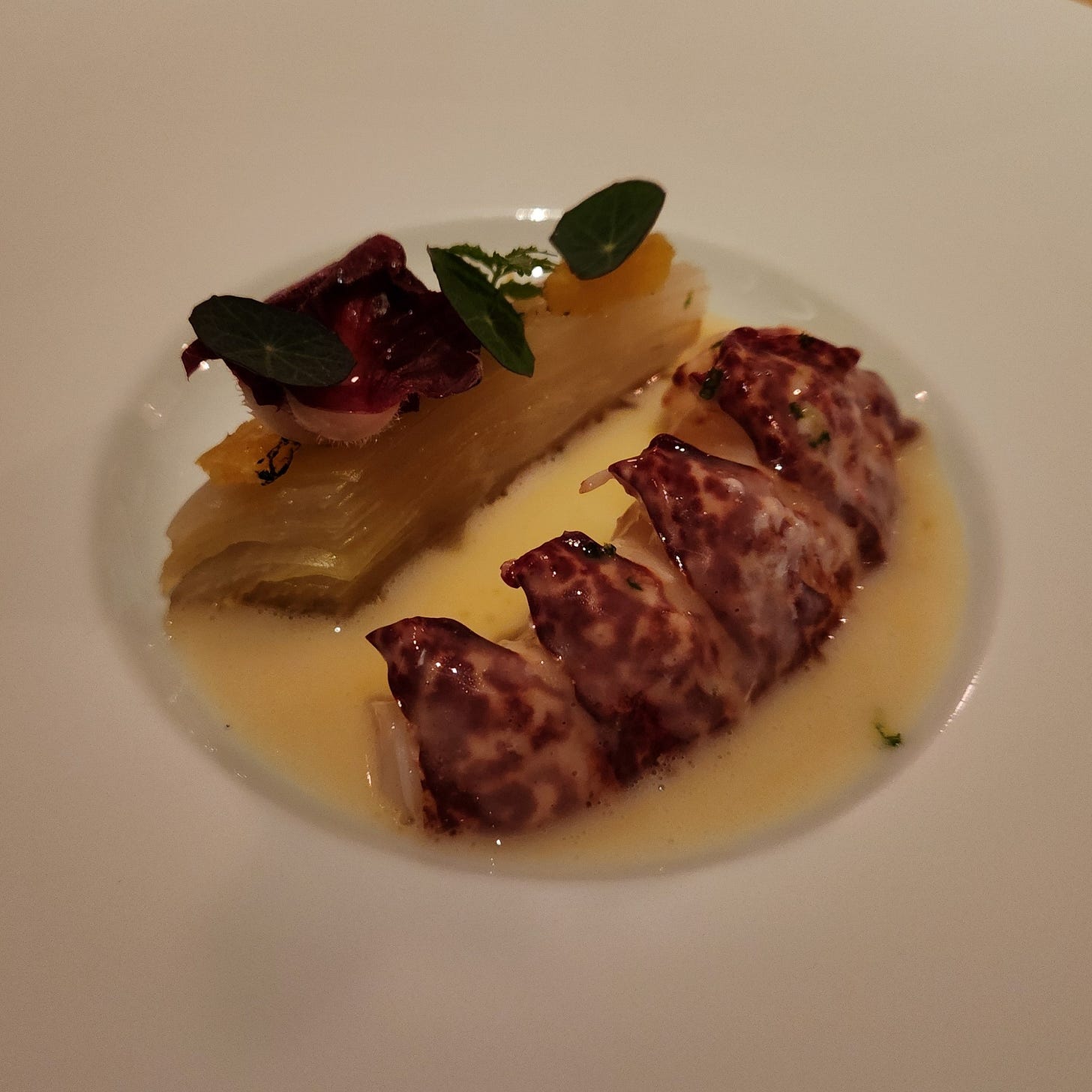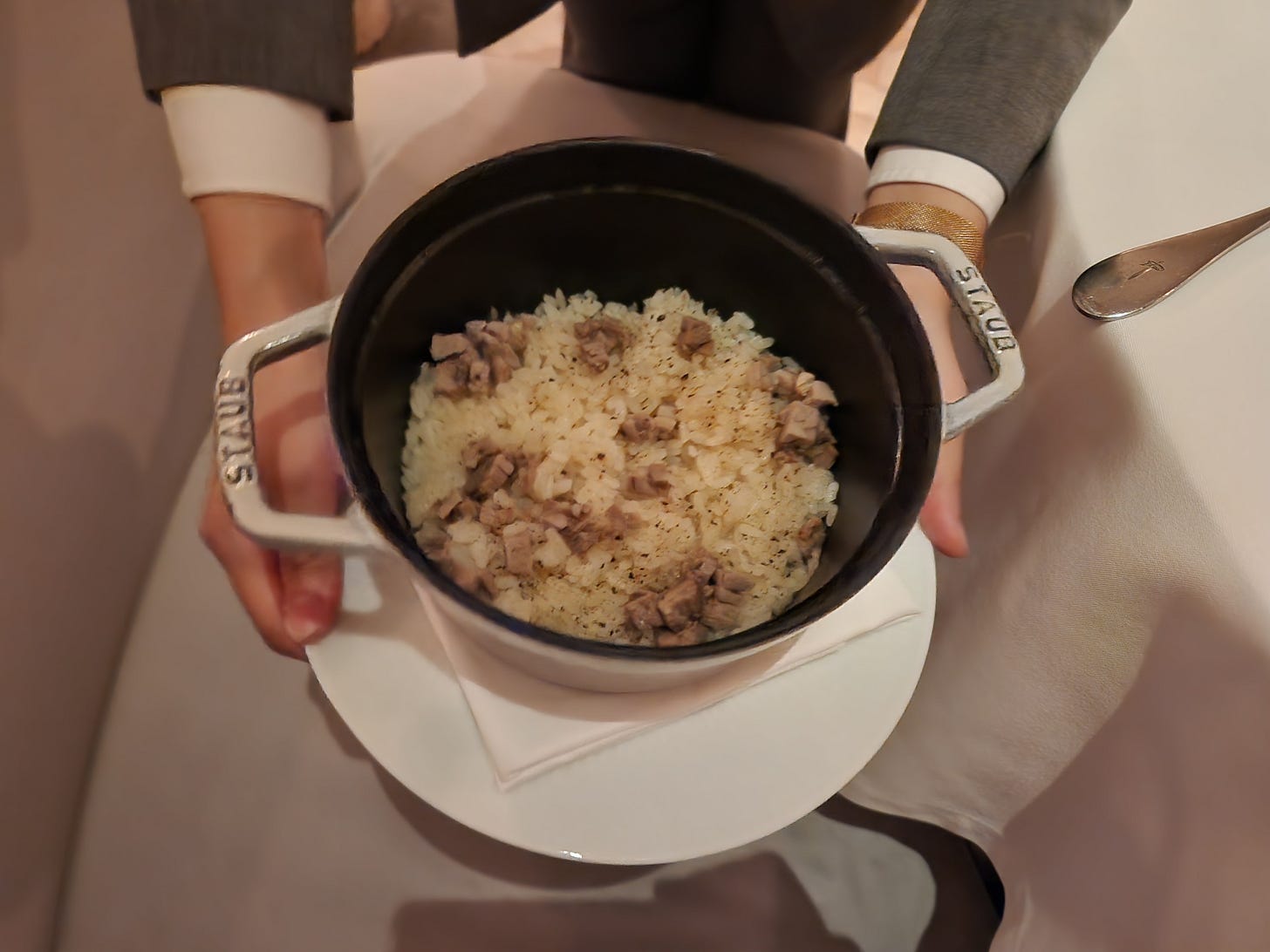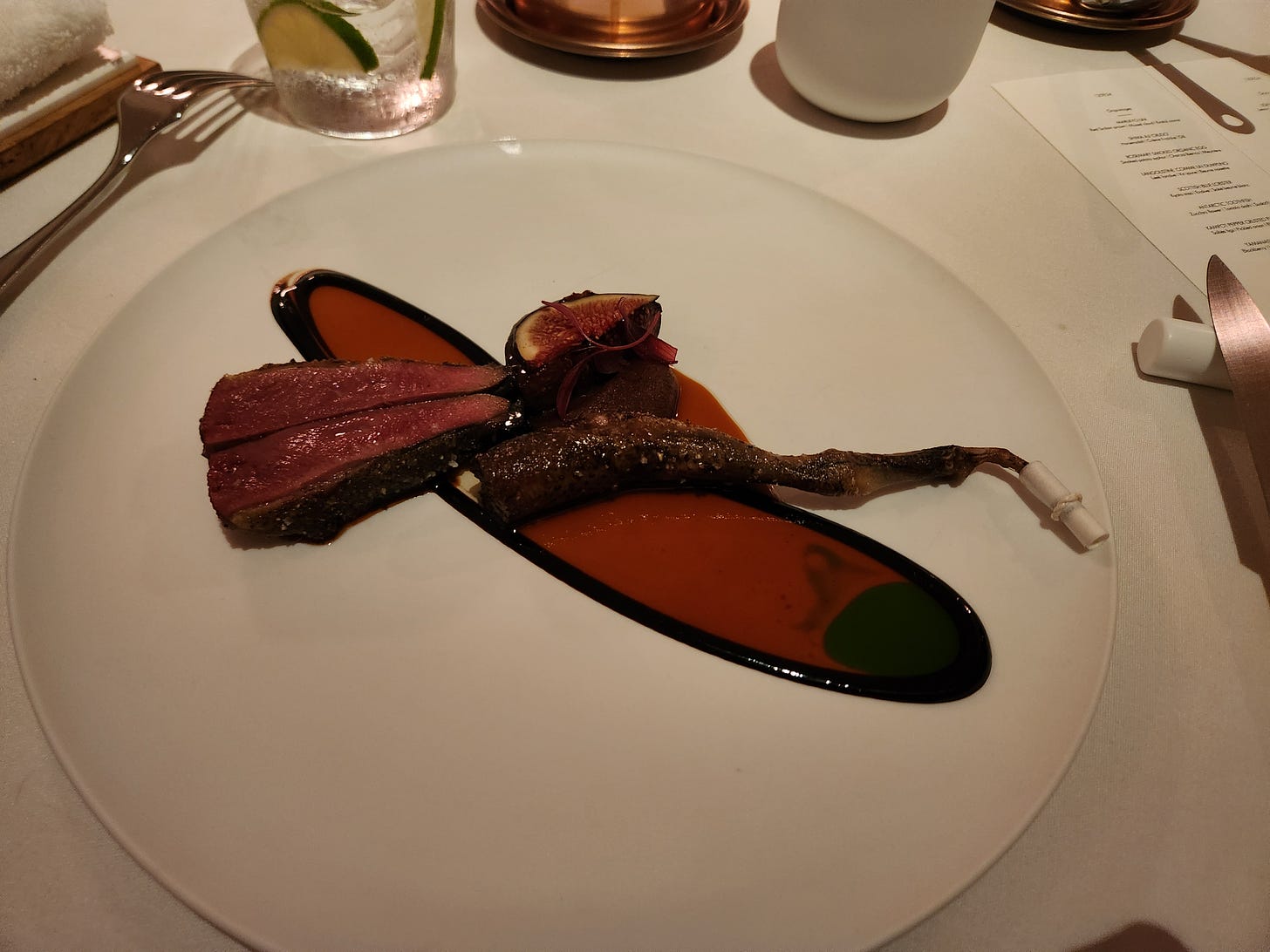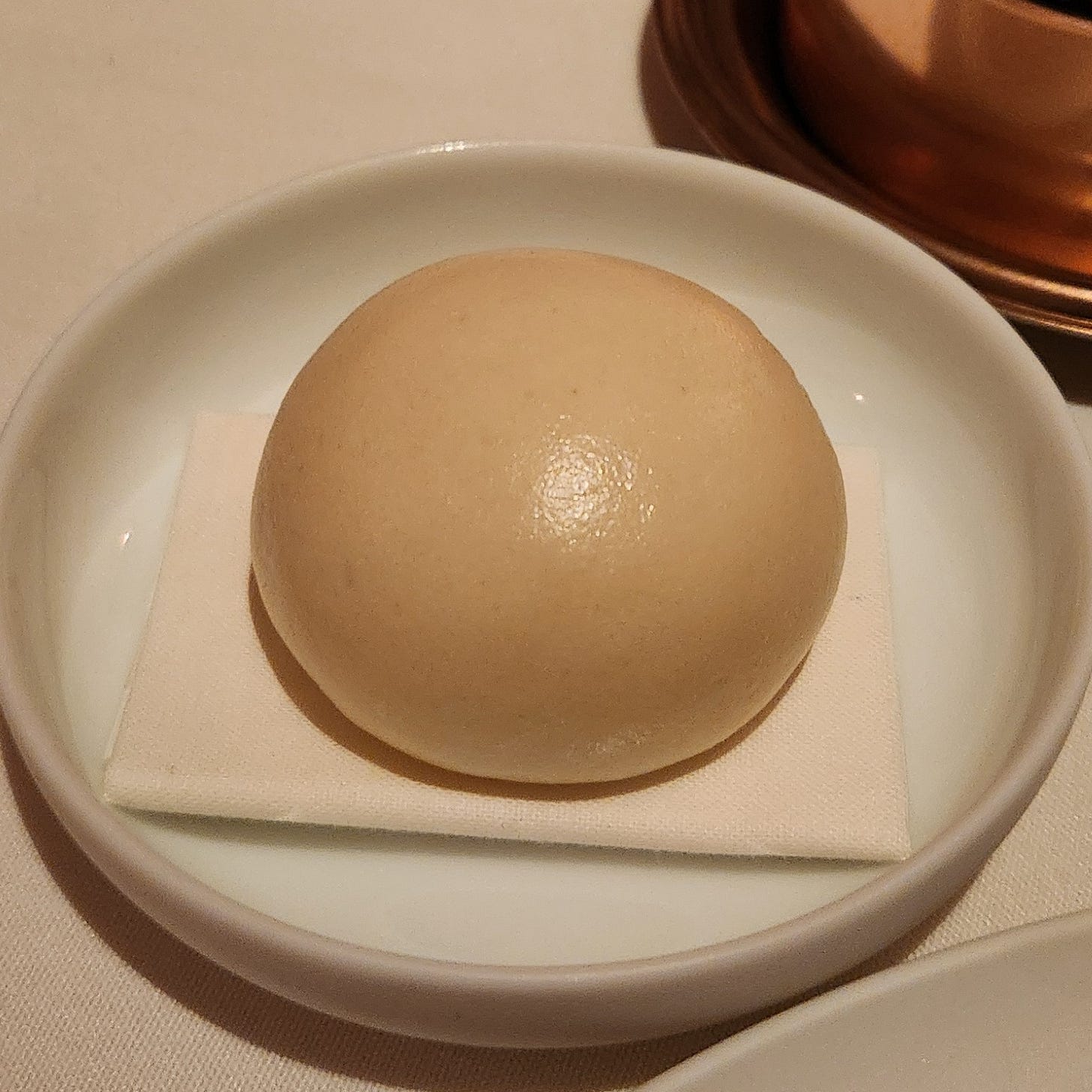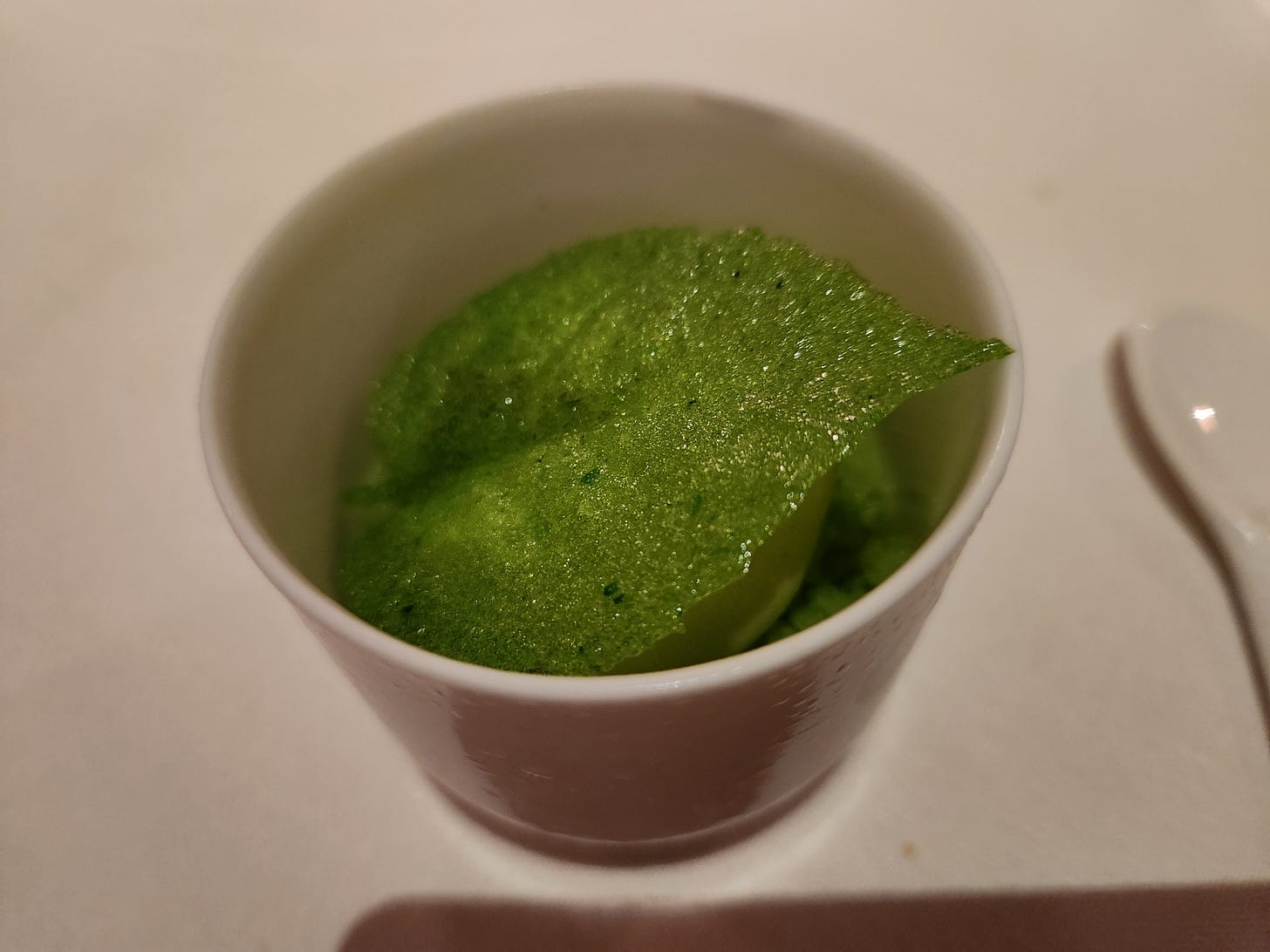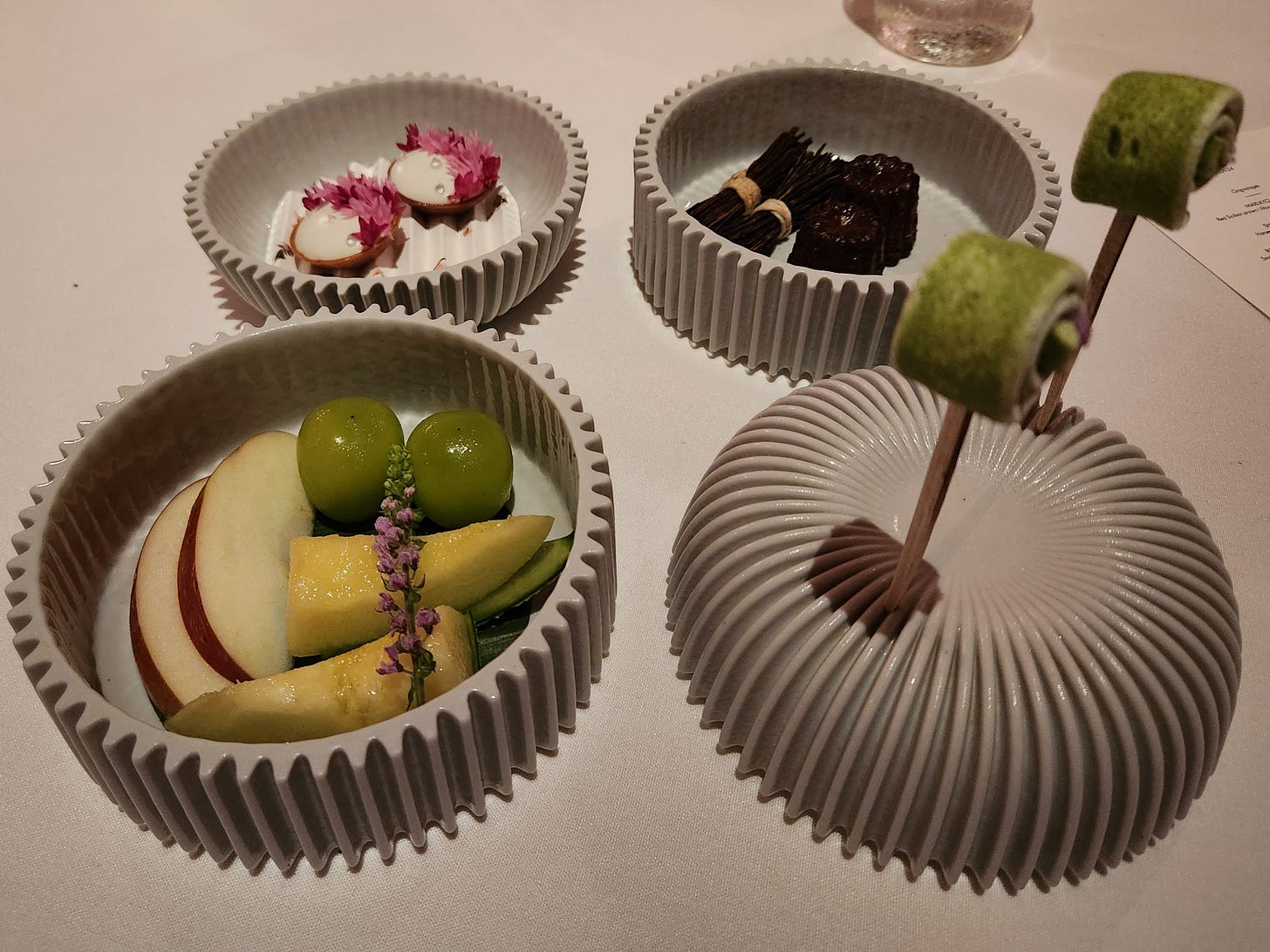Odette
Combining Classic French DNA with Asian Influences at the National Gallery in Singapore
The second of the French heavyweights in our head to head in Singapore, Odette, has been serving contemporary French cuisine in Singapore since 2015. Immediately, it achieved two Michelin stars in the inaugural Singaporean Michelin Guide in 2016. In 2019, same year as its archrival, Les Amis, it received its third Michelin star and it has held on to three stars until now.
Odette is headed by Chef Julien Royer, who started his career under Michel Bras, one of the few chefs to ever win three Michelin stars, and even rarer, voluntarily give them up. After working at other legendary restaurants like L’Ambroisie, Chef Julien eventually found his way to Singapore in 2008, where he worked across a series of restaurants before opening Odette in 2015.
Odette was named after, and is a tribute to Chef Julien’s grandmother, who first taught him to cook while he was still a young child. Born to a family of farmers, Chef Julien wanted to replicate the flavours from his childhood home in Auvergne, a humble agricultural region in the center of France. He wanted to highlight freshly picked produce, seasonal ingredients and using everything that the land provides, particularly emphasizing citrus and vegetables. In fact, beside the menu is a list of all the farms and producers that supply the kitchen.
In contrast to Les Amis’ strict adherence to French technique, French ingredients following the French seasons, Odette masterfully combines French technique and tradition with Asian influence and ingredients.
Unlike Les Amis’ nondescript location, Odette is centrally located within the beautiful National Gallery, down a high-ceilinged hallway paved with polished inset marble and through a set of wood framed glass doors, lies a room of white and pastel pinks, round banquettes around circular tables with crisp white tablecloths and matte white dishware, majority of which was sourced from J.L Coquet.
We were greeted at the door and ushered to our table near the back, where a perfectly folded hot towel and linen napkin was already waiting for us. There is a sense of precision at Odette: every fold, every angle has to be perfect. Every time one of us left the table, the napkin was removed, and replaced with a new, perfectly folded napkin in its proper place with a set of tongs.
First came a visit from the champagne trolley where we were presented with several choices of champagne, all especially bottled for Odette. I went with a glass of the Henri Giraud MV18, a multi-vintage blend with the dominant base being from the 2018 vintage Pinot Noir, combined with a small amount of Chardonnay, all from the Grand Cru region of Ay. A fairly dry and high acidity champagne with a long finish.
The amuse bouche, known at Odette as “grignotage” (or “grazing”) were presented on top of folded paper origami. Given some dietary restrictions we informed them about beforehand, then assured us that they could manage them, and adjusted the menu accordingly. Counterclockwise from the bottom, two warm, pillowy donuts - one filled with a raw unpasteurized French cheese, the other, white miso, followed by two prawn tacos in a delicate crisp shell - one in ceviche form, the other fully cooked, topped with flower petals, microgreen and some lightly fermented yuzu chili pepper. Finally, two sweet onion tarts, tasting of rich, slow-cooked caramelization.
We were then told to turn over what I thought was a large coaster, but was in actuality, the story of Odette.
We were then also presented with customized menus, each detailing what we would be served over the course of the night. For each one of the dishes, our wonderful waitress, Sarah Jane, explained what it was, how it was prepared, and substitutions or changes they proposed based on dietary requirements and made sure that we were comfortable with them. We were also presented with some additional courses we could add on, which we decided to share.
Throughout the dinner, our waitress did an amazing job not just explaining the dishes, but also engaged us in a lively discussion about how they put together the menu and plan around the seasons. Similarly to Les Amis, they do seasonal menus with four major overhauls a year. The signature dishes stay on the menu, but the accompaniments or garnishes may change with the seasons.
We also had a conversation about truffles, the right seasons for truffles and sourcing. As we learned, white truffle season is toward the end of the year, and usually sourced from Alba, Italy. Black truffles however, were best sourced from Western Australia and their peak season is in May. Given that we went to Odette in September, it was quite far from either truffle season, so the small truffles they did have were not showcased, and primarily used for the vegetarian menu.
Later in the night, there was also a discussion of Chef Julien’s cooking philosophy and how it evolved over time. Starting as a classic French chef, he focused on haute French cuisine - heavy, rich, flavourful sauces that Asian palates can struggle with. As he spent more time in Asia, he learned more about how delicate and elegant Asian cooking is, requiring finesse. He spent more time among Japanese chefs in particular, and was introduced to and started incorporated more Japanese ingredients in his cooking.
We were then served the last of the grignotage, and one of the signature dishes at Odette, their famous mushroom tea. Presented vertically stacked, like two giant toadstools, a rich egg custard with sliced mushrooms, a generous pour of hot mushroom broth, topped with walnuts and buckwheat for a bit of crunch and texture. It was so rich that if they didn’t explain it to me, I would’ve identified this as cream of mushroom soup. Continuing with the mushroom theme, the mushroom tea was accompanied by a slice of brioche spread with mushroom butter and topped with shaved mushrooms. Absolutely delicious and a huge hit.
At this point, my companion decided to get a drink, and as a teetotaller, decided on a Muri sherbet daydream, a dealcoholized sparkling redcurrant wine, mixed with some pickled rhubarb, douglas fir and juniper kefir. The aroma was a bit sour, but tasted quite refreshing, a bit tart and reminded me a bit of these vinegar-based drinks you can buy at 7-Elevens in Japan.
We were then presented with the bread course, two black olive brioche buns - flaky, fluffy with a crisp crust, two slices of rustic sourdough, some Spanish olive oil, and a pat of homemade garlic parsley butter, topped with microgreens and flower petals.
Continuing with the hits, the next course was a rich uni (sea urchin) tart served with shrimp crudo inside a dill creme fraiche foam, topped with a generous scoop of Kristal caviar. Unlike the rich, dark black I normally expect, this tin was closer to a dark olive or amber. The richness of the creme fraiche foam added to the chewy shrimp, and was cut by the pops of briny nuttiness from the caviar. There was also small cubes of granny smith apple that added a bit of sweet and crunch.
My companion was served a tomato tart, on a brioche bun, topped with tiny flowers, some tarragon and sorrel. The tomato was deseeded and salted to remove a bit of the liquid, and the tomato water was reserved to be used for another dish.
The next course was a Shima Aji (or Striped Jack) crudo on a creme fraiche bed, with four forms of dill jellies and oils and topped with a flash-frozen horseradish snow. The dill, horseradish and preserved fish combo always reminds me a bit of a New York lox bagel. All it needed was some capers, you could slap it on a toasted poppy seed bagel.
The substitute for my companion was an dumpling filled with picked Normandy brown crab and apple and pear sorbet, topped with coriander and a wrapped in a gelatinized wrapper.
Next, another signature and very theatric dish, the rosemary smoked egg. Presented in a box of smoking dry ice, organic eggs were cooked for 55 minutes at 63.5 degrees and cracked into a buttery potato foamed filled with salty fried cubed chorizo. Smoking rosemary underneath the dish continued to add to the rosemary aroma as we began to tuck in. The combination of egg, potato and crispy ham texture and flavours reminded me a lot of my favourite breakfast comfort foods. It’s obvious why this is one of Odette’s signature dishes, and an absolute hit.
By this point, I had finished my glass of champagne and decided to switch to something nonalcoholic. The Lapsang Kombucha sounded interesting, so I decided to give it a try. Lapsang Souchong tea is brewed and fermented into kombucha inhouse, and served with a piece of candied ginger. The sweetness and spiciness of the candied ginger helps offset some of the sour tones of the kombucha and made for a very refreshing drink.
The optional additional course came next, a piece of perfectly cooked langostine topped with a shiso leaf, wrapped with a sheet of yuzu jelly and topped with a rich leek fondue beurre noisette sauce. By itself, the sauce was quite strong and sour, but when coating the langostine, worked really well together.
The next seafood course was a Scottish blue lobster tail, pan-fried and served with endives braised in dashi in a rich beurre blanc sauce topped with tarragon leaves. Plump, perfectly cooked lobster still slightly translucent in the center, paired well with the slightly bitter endives.
The final seafood course before the mains, an Antarctic toothfish, accompanied with a zucchini flower stuffed with minced shrimp and squid on a bed of tomato paste and topped with raw hazelnuts and flowers. The toothfish was topped with a bit of tarragon leaves and the entire dish was sauced with a basil oil and tomato water reduction.
We were starting to get a bit full, so to give us a bit of a break, they ceremonially presented our mains - pigeon for me, chicken for my companion.
While not impressive looking, this was the highlight of the next course - Odette’s take on a classic dish every Singaporean would know - the Singaporean chicken rice. Freshly steamed Japanese rice mixed with hot shallot oil, shredded chicken thigh and crispy baked chicken skin.
The Pigeon was beautifully presented, with a piece of breast and leg accompanied by some stewed figs on pickled onion and a thick, rich sauce and some basil oil. Attached to the foot was a small note from Chef Julien. I’ll admit that I didn’t understand it, but a whimsical addition to the dish nonetheless.
The accompaniment to the pigeon, a classic Chinese steam bun, but instead of BBQ pork, they used the pigeon offal. They recommended that we use the bun to dip into the sauce from the pigeon.
A three Michelin star take on the Singaporean chicken rice, a humble-looking piece of chicken breast, sauced with an albufera sauce, served with green beans and some vinegared mushrooms.
The showstopper - the humble-looking chicken oil rice from earlier, topped with some additional chicken skin. This reminded me a lot of the chicken rice at Louise, another Chef Julien restaurant in Hong Kong. At both restaurants, it’s absolutely amazing, and a must-order dish if it’s on the menu.
The accompaniment to the chicken rice was… more chicken. A fried chicken wing stuffed with more minced chicken and wood ear mushroom.
We were offered a selection off the cheese trolley for an additional 50 SGD/person. Given that we were more stuffed than the earlier chicken wing, we elected to pass.
However, I did elect for a very interesting 1988 Madeira Terrantez . Normally, I think of Madeiras as very similar to Port, but Madeiras are “sun-aged” in high heat . The Terrantez varietal is a low-yielding wine which has resulted in vineyards producing the grape declining over time. The producer, D’Oliveira, believes that Madeiras age best in their wood casks, and they are left to age there until an order comes in, at which point they are bottled. The end result is a dry, thick, cola-brown Madeira and a satisfying drink to end the meal with.
The pre-dessert was a apple-flavoured sugar leaf, on top of a loose basil foam, on top of a sorrel frozen yoghurt, on a shiso leaf granita, hiding a aloe vera and golden kiwi jelly at the bottom. Layers of contrasting textures and flavours.
For dessert, a rose jelly wrapper covering two kinds of peach - some from Japan, some from France, studded with blackberries on top of a crispy hojicha meringue, all covered with a rose jus.
A surprise! Fresh strawberries on a crisp tart shell topped with a fromage blanc sorbet and surrounded with a strawberry basil reduction.
Finally, the petits fours. There’s an interesting story behind these the dishes the petits fours were served in. Apparently, Chef Julien is a huge fan of the Paris Saint-Germain football club, and the dish was custom designed to look a bit like PSG’s home stadium. The first two versions of the dish looked a bit more like the stadium, but the thin, radiating fins chipped easily, so in this third version, the fins were thickened and shortened to prevent chipping.
Clockwise, from the bottom right, a marshmallow lollipop sprinkled with matcha, some Japanese fruit - rock melon, fuji apple slices and muscat, violet tarts - filled with frangipane and raspberry, double-baked classic French canneles.
By this time, we were completely stuffed, so we barely nibbled on the petits fours. Ultimately, it was the fresh fruit that we finished, one piece each of perfectly ripe, peak season fruit flown straight from Japan.
I came to Singapore with the goal of comparing the two French culinary giants - Les Amis and Odette, expecting slight variations on central French themes. However, the two restaurants could not be more different. Les Amis prides itself on a very authentic French approach to French cuisine, while Odette is much more experimental both in presentation and flavour, incorporating influences from Japan, China, and Singapore as well other Asian countries.
The execution of both restaurants was superb, with Les Amis taking a slight edge on execution, while Odette clearly won on showmanship. Les Amis takes an approach where everything is included. The only decision you need to make is which menu you’re going with, while Odette gives you some choices of additions, substitutions or supplements.
One thing that really stood out at Odette was the service. Perhaps it’s down to the individual server, but our waitress spent the night in wide ranging conversations with us, talking about the providence of the ingredients, influences in the menus, talking about some of the movements between Chef Julien’s restaurants, the history of Odette, the themes around their dishware and silverware, and many other things. After our dinner, she was walking us through the National Gallery to the vehicle pickup point, and I half suspected she was going to start giving us a walking tour of the Gallery. This made the night particularly memorable, learning more about the food, the restaurant and everything that goes into putting together a three Michelin star meal.
Total Damage: 1500 SGD/2 people


